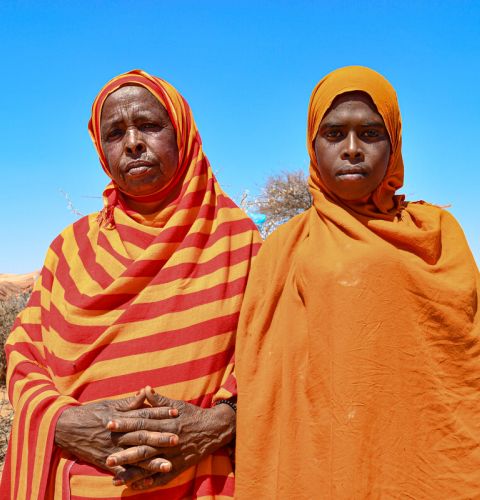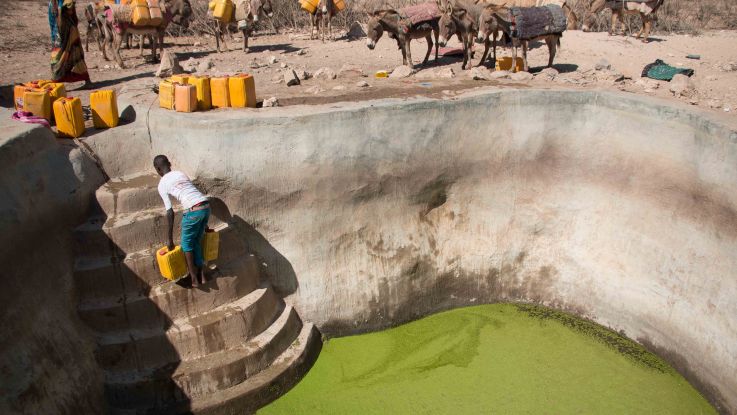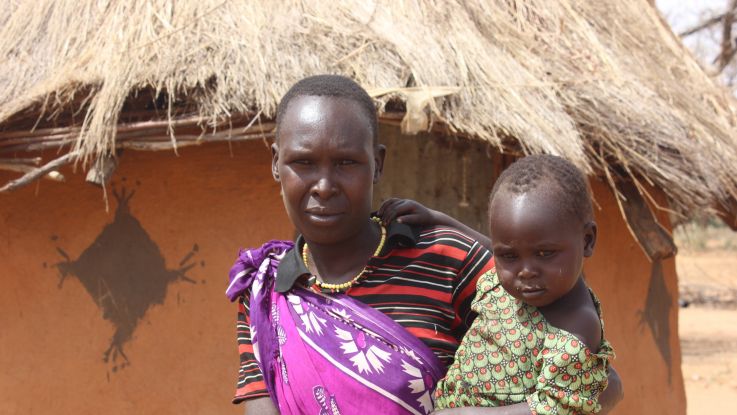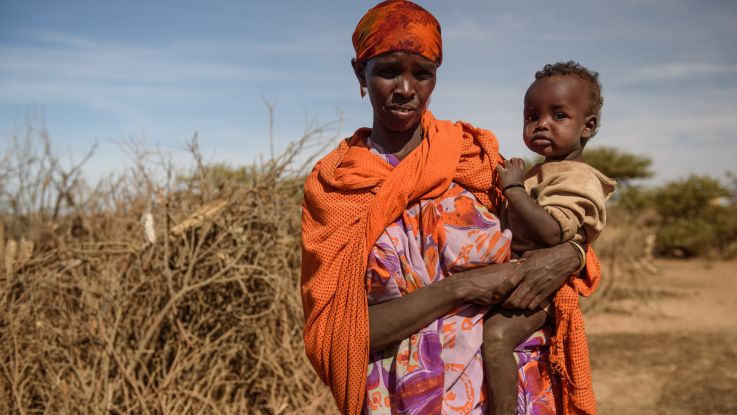Food crisis in East Africa 2017-2023
Is there a famine in East Africa?
As of 2025, there is an extreme food crisis in several parts of East Africa.
While current levels of hunger and projections in East Africa are not classified as “famine” under the internationally recognised system of measuring food insecurity, Kenya, Somalia and Ethiopia3 are facing acute food insecurity.
Meanwhile, famine conditions have been confirmed in Al Fasher and Kadugli in Sudan as of September 2025, with the risk of famine in 20 additional areas across Greater Darfur and Greater Kordofan.4
Famine is a technical classification that defines a catastrophic level of food insecurity that results in people dying from not having enough food to eat.
Acute food insecurity is defined when people are unable to eat enough food that puts their lives or livelihoods in immediate danger.5
These classifications are set by the Integrated Food Security Phase Classification (IPC) which measures food insecurity from a range of 'Level 1- minimal' to 'Level 5 - famine'.
Find out more about how famine is classified and what causes it.
Hunger in East Africa
Millions of people in Ethiopia, Kenya and Somalia are facing hunger following increasingly intense and recurrent cycles of flooding and drought in East Africa and as a consequence of the Russia-Ukraine war.
Years of failed rainy season and the fluctuation of drought and flash flooding compounded by the lack of wheat exports from Ukraine during the current war, is driving hunger in East Africa. Over 40% of wheat used in Africa came from Russia and Ukraine prior to the conflict.6
Approximately 12.2 million children under 5 years old are acutely malnourished in East Africa including 3 million with severe acute malnutrition.7
What is happening in Ethiopia?
Following four consecutive failed rainy seasons since 2020, Ethiopia faced an extended La-Nina produced drought that decimated crops and livestock, leading to severe food and water shortages in the region.
In 2024, the country experienced significant flooding due to heavy rainfall which exacerbated existing food insecurity. The crisis was further deepened by fragile political and socio-economic conditions, creating compounded challenges for already strained household and community capacities. Additionally, the influx of more than 100,000 refugees from Sudan is further burdening the country's limited resources and services.
Over 10 million people in Ethiopia are acutely food insecure.8 More than four million pregnant women, breastfeeding women and young children need treatment for malnutrition.
What is happening in Kenya?
As of November 2025, Kenya is experiencing a severe and worsening drought, driven by a forecast of below-average October-December short rains and high temperatures.
Nearly 1.8 million people are currently experiencing high levels of acute food insecurity. The FAO and WFP warn that the situation is worsening and threatening to drive millions more into famine or risk of famine.9
What is happening in Somalia and Somaliland?
Poor rainfall, flooding as well as persistent conflict has driven driving 3.4 million people into high levels of acute food insecurity across Somalia.10 Humanitarian food assistance needs are expected to increase, with 5.0-5.99 million people projected to be in need from February to April.
As of June 2025, the population of internally displaced persons (IDPs) due to conflict and the impact of climate change totalled an estimated 3.5 million (20 percent of the total population).
Somaliland, one of the hardest-hit regions in the Horn of Africa, is suffering from prolonged drought, high food prices, and rising conflict and displacement. The area has seen the failure of five consecutive rainy seasons and below-average rainfall in six. Despite increased precipitation from El Niño in other parts of the region, Somaliland remains largely dry, with insufficient rain to support farming or livestock.
What is ActionAid doing to help Ethiopia, Kenya and Somaliland?
ActionAid have reached 141,109 people in Ethiopia since 2022. Our response activities include food distribution, protection support, multipurpose cash distribution and health support.
In Kenya, ActionAid reached 149,682 people from March to October 2025. We are providing cash transfers to affected households as well as distributing water, seed and dignity kits.
In Somalia, 72,689 people have been reached by ActionAid from March to October 2025. We have supported direct humanitarian WASH services and provided cash support to households and IDPs.
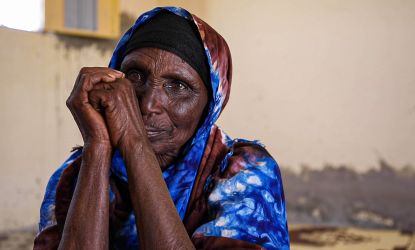
Hunger in Somaliland
Amina, 90, has survived 12 droughts in her lifetime, but says the current situation in Somaliland, is the worst she’s experienced.
Amina has seen first hand the devastation caused by the drought in her hometown.
“The drought has hit us hard. We have no water. Fuel is very expensive. We used to eat sorghum, rice, pasta and macaroni. But now we do not have the money to buy these foods. We are starving,” she said.
Families are only able to access one working well once every seven days. Some resort to digging holes with their bare hands in search of water, but more often than not, they find dirty, muddy water.
Like Amina, millions of others in East Africa are struggling with a food crisis that is affecting their food and water supplies. Now rising food and energy prices are pushing families to the brink of survival.
ActionAid is working with local women and partner organisations in East Africa to provide food, water, and help rebuild livelihoods.
Previous food crises in East Africa: 2019-2020
What happened in Somalia and Somaliland?
In Somalia and Somaliland, 2.2 million people were at risk of hunger11 in 2019, after the driest seasons in three decades.
Communities in the region were struggling to recover from the 2017 drought which was extended by hot, dry weather conditions in 2018 and 2019.
Prolonged dry conditions across the region led to farmland and pastures failing, loss of livestock, increased food prices, and reduction of the availability of water in large areas of Somalia and Somaliland.
What happened in Kenya and Ethiopia?
In Kenya, rains were delayed across the whole country leaving 2.3 million people in a food crisis in 2019.
In Ethiopia, the eastern and southern-eastern areas were experiencing drought while other regions are affected by flooding. 8.8 million people are in need of assistance.
What did ActionAid do to help Somaliland, Kenya and Ethiopia?
In 2019, around 850,000 people in Somaliland were in need of food assistance. ActionAid provided 725 families with cash transfers. These cash transfers went directly to women to empower them to decide how best to prioritise their families’ needs. Women spend these monthly cash transfers on food, water, shelter and medicine.
In Kenya, ActionAid delivered urgently needed food by distributing 6,088 food parcels to the worst hit households and setting up a school feeding programme to provide a daily meal to keep over 5,000 children in school.
In Ethiopia, 1974 people including 1,160 women were provided with one-month cash transfers for food.
In all the regions, ActionAid also distributed sanitary kits and trained women's coalitions in leadership skills to identify the needs of their community.
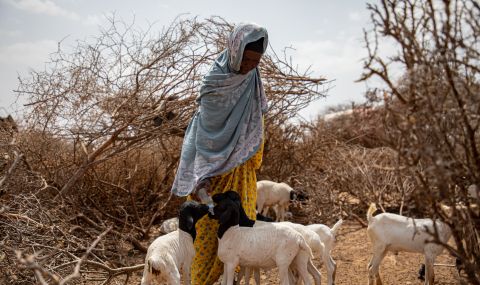
Aisha, a 60-year-old pastoralist in Somaliland has had to migrate to find water for her livestock.
Previous food crises in East Africa: 2017
What happened in Somaliland, Kenya, Ethiopia and South Sudan?
In Somaliland, 6 million people were affected by the drought.
In Kenya, the drought left 2.7 million people in need of humanitarian assistance and in Ethiopia, 5.6 million people needed food aid.
In South Sudan, a famine was officially declared in 2017 with 4.6 million people in urgent need of food.
What did ActionAid do to help in Somaliland, Kenya, Ethiopia and South Sudan?
ActionAid supported 64,000 people in Somaliland, 130,000 people in Kenya, and 38,000 people in Ethiopia during the drought in 2017.
This included providing cash transfers, rehabilitating water sources, and school feeding programmes. We also provided food, including cereals, pulses and oil, to malnourished children and lactating and pregnant women.
ActionAid does not have a programme in South Sudan. To respond most effectively to the 2017 food crisis in East Africa, we used scarce and valuable resources by building on where we already had a presence and capacity such as in Ethiopia, Kenya, and Somaliland. Starting a programme in South Sudan would have demanded considerable time and money that could have been used to meet the immediate needs of communities that we already worked with.
However, by working with other agencies, for example, through our involvement in the Disasters Emergency Committee (DEC), we ensured that work across the region was coordinated and that other agencies were responding to needs in South Sudan.
Food crises: key facts
What causes food crises?
Food crises are caused by various complex factors including climate-induced changes and disasters such as conflicts in a particular region over time.
These events can cause extended droughts or other climate-related events like cyclones and floods. Erratic changes in the weather like lack of rain or extreme rainfall can result in crop failures and loss of livestock. This in turn can raise food prices and can cause road blockages, hindering transport of food.
Where is East Africa located?
East Africa is situated in the northeastern part of the African continent. From Tanzania in the south, through Kenya and Uganda and across Ethiopia is all part of East Africa.
Which are East African countries?
East Africa is part of sub-Saharan Africa comprising two regions:
- Kenya, Tanzania, Uganda and South Sudan;
- The Horn of Africa, which encompasses Somalia, Somaliland, Djibouti, Eritrea, and Ethiopia.
Footnotes
- 1
https://www.unocha.org/publications/report/sudan/eastern-africa-humanitarian-snapshot-march-2025
- 2
https://www.oxfam.org.uk/donate/the-unseen-crisis-unfolding-in-east-africa/
- 3
https://martinplaut.com/2025/08/06/worsening-drought-conflict-push-millions-in-ethiopia-into-acute-food-insecurity-fews-net-warns/#:~:text=Acute%20food%20insecurity%20remains%20widespread,Systems%20Network%20(FEWS%20NET).
- 4
https://www.ipcinfo.org/ipc-country-analysis/details-map/en/c/1159787/?iso3=SDN
- 5
https://www.fao.org/newsroom/detail/global-report-on-food-crises-acute-food-insecurity-hits-new-highs/en#:~:text=Acute%20food%20insecurity%20is%20when,IPC)%20and%20the%20Cadre%20Harmonis%C3%A9.
- 6
https://cerf.un.org/news/press-release/un-emergency-fund-allocates-us45-million-stave-famine-risk-horn-africa
- 7
https://www.fsinplatform.org/report/global-report-food-crises-2025/#east-africa
- 8
https://news.un.org/en/story/2025/04/1162456
- 9
https://www.fightfoodcrises.net/hunger-hotspots
- 10
https://www.ipcinfo.org/ipc-country-analysis/details-map/en/c/1159740/?iso3=SOM
- 11
https://cerf.un.org/news/press-release/un-emergency-fund-allocates-us45-million-stave-famine-risk-horn-africa
Page updated 18 December 2025
